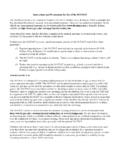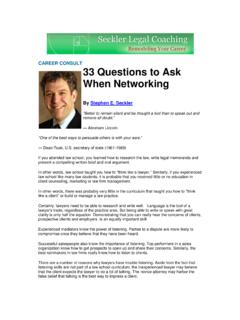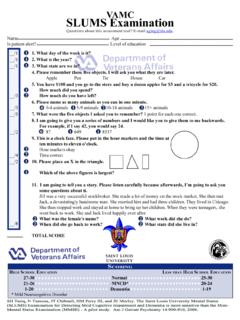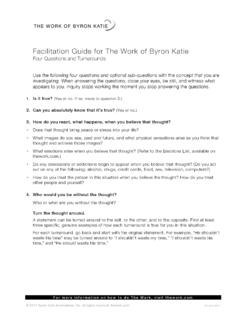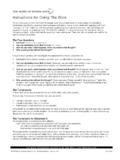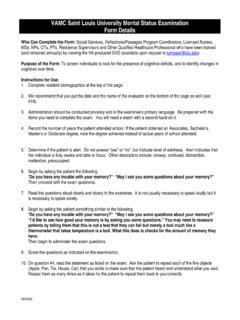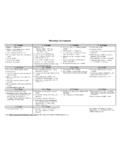Transcription of Instructions and Permissions for Use of the M-CHAT
1 Instructions and Permissions for Use of the M-CHATThe Modified Checklist for Autism in Toddlers ( M-CHAT ; Robins, Fein, & Barton, 1999) is available forfree download for clinical, research, and educational purposes. There are two authorized websites: the M-CHAT and supplemental materials can be downloaded from or from Dr. Robins website, at ~wwwpsy/ should be aware that the M-CHAT continues to be studied, and may be revised in the future. Anyrevisions will be posted to the two websites noted , the M-CHAT is a copyrighted instrument, and use of the M-CHAT must follow theseguidelines:(1) Reprints/reproductions of the M-CHAT must include the copyright at the bottom ( 1999 Robins, Fein, & Barton).
2 No modifications can be made to items or Instructions withoutpermission from the authors.(2) The M-CHAT must be used in its entirety. There is no evidence that using a subset of items willbe valid.(3) Parties interested in reproducing the M-CHAT in print ( , a book or journal article) orelectronically ( , as part of digital medical records or software packages) must contact DianaRobins to request permission for UseThe M-CHAT is validated for screening toddlers between 16 and 30 months of age, to assess risk forautism spectrum disorders (ASD). The M-CHAT can be administered and scored as part of a well-childcheck-up, and also can be used by specialists or other professionals to assess risk for ASD.
3 The primarygoal of the M-CHAT was to maximize sensitivity, meaning to detect as many cases of ASD as , there is a high false positive rate, meaning that not all children who score at risk for ASD willbe diagnosed with ASD. To address this, we have developed a structured follow-up interview for use inconjunction with the M-CHAT ; it is available at the two websites listed above. Users should be aware thateven with the follow-up questions, a significant number of the children who fail the M-CHAT will not bediagnosed with an ASD; however, these children are at risk for other developmental disorders or delays,and therefore, evaluation is warranted for any child who fails the M-CHAT can be scored in less than two minutes.
4 Scoring Instructions can be downloaded ~wwwpsy/ or We also have developed ascoring template, which is available on these websites; when printed on an overhead transparency and laidover the completed M-CHAT , it facilitates scoring. Please note that minor differences in printers maycause your scoring template not to line up exactly with the printed who fail more than 3 items total or 2 critical items (particularly if these scores remain elevatedafter the follow-up interview) should be referred for diagnostic evaluation by a specialist trained toevaluate ASD in very young children. In addition, children for whom there are physician, parent, or otherprofessional s concerns about ASD should be referred for evaluation, given that it is unlikely for anyscreening instrument to have 100% fill out the following about how your child usually is.
5 Please try to answer every question. If the behavioris rare ( , you've seen it once or twice), please answer as if the child does not do Does your child enjoy being swung, bounced on your knee, No2. Does your child take an interest in other children?Yes No3. Does your child like climbing on things, such as up stairs?Yes No4. Does your child enjoy playing peek-a-boo/hide-and-seek?Yes No5. Does your child ever pretend, for example, to talk on the phone or take care of a doll orYes Nopretend other things? 6. Does your child ever use his/her index finger to point, to ask for something?Yes No7. Does your child ever use his/her index finger to point, to indicate interest in something?
6 Yes No8. Can your child play properly with small toys ( cars or blocks) without justYes Nomouthing, fiddling, or dropping them?9. Does your child ever bring objects over to you (parent) to show you something?Yes No10. Does your child look you in the eye for more than a second or two? Yes No11. Does your child ever seem oversensitive to noise? ( , plugging ears)Yes No12. Does your child smile in response to your face or your smile? Yes No13. Does your child imitate you? ( , you make a face-will your child imitate it?)Yes No14. Does your child respond to his/her name when you call? Yes No15. If you point at a toy across the room, does your child look at it?Yes No16. Does your child walk?
7 Yes No17. Does your child look at things you are looking at? Yes No18. Does your child make unusual finger movements near his/her face?Yes No19. Does your child try to attract your attention to his/her own activity?Yes No20. Have you ever wondered if your child is deaf?Yes No21. Does your child understand what people say?Yes No22. Does your child sometimes stare at nothing or wander with no purpose?Yes No23. Does your child look at your face to check your reaction when faced withYes Nosomething unfamiliar? 1999 Diana Robins, Deborah Fein, & Marianne Barto
